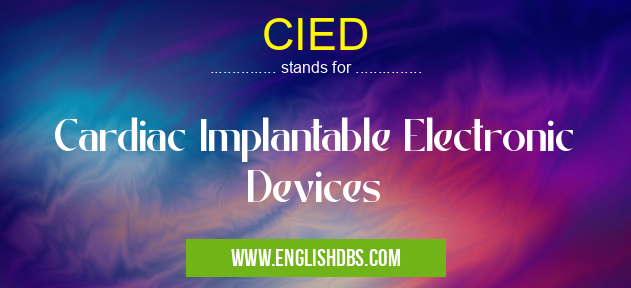What does CIED mean in CARDIOLOGY
Cardiac Implantable Electronic Devices (CIED) are medical devices implanted in a patient's body to treat or monitor irregular heart rhythms. CIEDs help manage and control arrhythmias, which can be caused by various factors such as diabetes, genetics, or even smoking. These devices are especially helpful for patients who suffer from more severe cases of arrhythmia that cannot be controlled with medications or lifestyle changes.

CIED meaning in Cardiology in Medical
CIED mostly used in an acronym Cardiology in Category Medical that means Cardiac Implantable Electronic Devices
Shorthand: CIED,
Full Form: Cardiac Implantable Electronic Devices
For more information of "Cardiac Implantable Electronic Devices", see the section below.
» Medical » Cardiology
Essential Questions and Answers on Cardiac Implantable Electronic Devices in "MEDICAL»CARDIOLOGY"
What is a Cardiac Implantable Electronic Device?
A Cardiac Implantable Electronic Device (CIED) is a medical device that is implanted in the body for the purpose of monitoring and treating abnormal heart rhythms (arrhythmias).
Who needs a Cardiac Implantable Electronic Device?
Cardiac Implantable Electronic Devices are used to manage and treat arrhythmias, especially when medications and lifestyle changes are not enough. People who have experienced more serious forms of arrhythmia may need to get a CIED in order to control their heart rate.
How does an implantable device work?
The device is made up of several components, including wires that sense the heart's electrical signals, an internal pacemaker generator, and electrodes for transmitting signals through the skin. The device monitors the patient's heartbeat and sends out electrical signals to adjust for any irregularities. It can also alert the doctor if any changes or problems arise.
Are there any risks associated with implanting an electronic device?
Though rare, some possible complications associated with CIED implantation include infection at the site of insertion, bleeding at the site of insertion, pneumothorax (air in chest cavity), perforation (tearing) of surrounding structures like blood vessels or chambers of the heart, and lead fractures due to wear-and-tear over time. Reactions such as swelling and redness at the site may also occur after implantation
Does insurance cover CIEDs?
Most insurance plans will cover all or part of a cardiac implantable electronic device if deemed medically necessary by your doctor. However it is important to check with your provider prior to receiving one of these devices for coverage information.
Final Words:
Cardiac Implantable Electronic Devices (CIEDs) provide invaluable assistance in monitoring and/or treating abnormal heart rhythms in those whose irregularity poses health risks beyond what medications or lifestyle changes can address. Although there are potential risks associated with implantation it is important to consult with your doctor should you feel this level of care might benefit you so you can make an informed decision about going forward with this type of treatment option.
